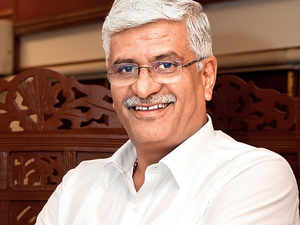
On ‘Nal Se Jal’ being too tall an order
Of the 18 cr rural households, only three crore have piped water. We have to do four times the work done in the past 70 years. So yes, it is a challenge. We have held several rounds of consultations with states and they are on board. We have asked them to prepare plans in three ways. One, for retrofitting, wherein a village infrastructure is mostly ready and there is sustainable water sources and only piped connectivity is needed. For these projects, we have already released some funds. Two, where a connection to underground or surface water source can be given immediately. Three, there are the bigger projects like in Bundelkhand which require longer gestation. We have sensitised states that the next six months are very crucial and they must work on all three project types simultaneously. We have started reviews to assess teething problems. There is a technical committee chaired by the principal scientific advisor to the PM for the evaluation of these projects. We are aiming that all these can be completed in the next three years.
On water use charges
Yes, we have proposed a nominal fee model to all states and requested them to bring in user charges. States have to decide how much they should charge, as water is a state subject. Our ‘Jal Se Nal’ scheme is so designed that there is public ownership built in. We have told states that up to 10% of the total expenditure on piped connectivity in a general village, and up to 5% in an SC/ST village, should be raised by them. The Paani Samiti of every village will also handle the village operations and maintenance of the project. The 5-10% raised by the village will be deposited with the Paani Samiti. So, through its interest, it can maintain the infrastructure.
Lok Sabha Elections#Elections With 
- All
- Uttar Pradesh
- Maharashtra
- Tamil Nadu
- West Bengal
- Bihar
- Karnataka
- Andhra Pradesh
- Telangana
- Kerala
- Madhya Pradesh
- Rajasthan
- Delhi
- Other States
On the plan being too capital intensive
The rate of return will be several times higher. Sustainable development goals apart, consider the huge opportunity the Jal Jeevan Mission offers for business and for employment. In 6 lakh villages, ensuring drinking water supply will generate new employment as plumbing will be required everywhere. We expect direct employment for over 12 lakh people at least. Then, creation of infrastructure, cement tanks, PVC pipes, will also show a big big boom in the rural economy within the next two quarters. The immeasurable impact is on the quality of life of the women walking miles to bring water and the health improvement that will come with supply of clean drinking water.
On agricultural overuse of water
In all countries, irrigation is the biggest use. In our country, dependence is highest on ground water for all segments and we haven’t worked much on water use efficacy. This is a big challenge because traditionally we have been growing water guzzling crops and there is resistance to new technology and crops. There are calls that states have to take. In Punjab, where ground water withdrawal is high due to free electricity, the state government has started an initiative to incentivise farmers to save electricity. In Maharashtra, the Devendra Fadnavis government has decided that within two years, those growing sugarcane have to move to drip irrigation.
All states have to do similar things.
At the Centre, we are committed to sustainability of water source and grey water use which are an integral part of the Jal Jeevan mission. The idea is to create a model where grey water can be treated and used as a source of revenue –– for horticulture/agriculture or ground water recharge. Jal Shakti Abhiyan has taken that message to every village–– over one lakh water bodies were rejuvenated as part of the mission.
On revisiting the Indus Water Treaty
This is the holiest of treaties and we have always honoured it and will always do so. As per the treaty, there are three rivers in India’s water share. There are also many tributaries that fall within the same share, but we do not currently have the infrastructure to tap it. As a result, it all flows into Pakistan. We have begun a techno-feasibility study on utilisation of this water. The study will be completed in the next 3-4 months and we hope that we will have our full share of water over the next 4-5 years.
On river interlinking plans
We have four links on priority and in final stages. There are minor issues which have to be reconciled between Madhya Pradesh and Uttar Pradesh on the Ken-Betwa link which we hope to resolve soon. We are also working on river interlinking in Maharashtra and Gujarat and Madhya Pradesh and Rajasthan and I am quite positive it will happen.
Download The Economic Times News App to get Daily Market Updates & Live Business News.
Subscribe to The Economic Times Prime and read the ET ePaper online.
Read More News on
Download The Economic Times News App to get Daily Market Updates & Live Business News.
Subscribe to The Economic Times Prime and read the ET ePaper online.













 Get Unlimited Access to The Economic Times
Get Unlimited Access to The Economic Times
